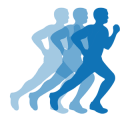Iliotibial Band Syndrome (ITBS), an overuse injury, is a prevalent source of lateral knee pain, particularly among runners.
Medically reviewed by Dr Chaminda Goonetilleke, 22nd Dec. 2021
Iliotibial band symptoms & diagnosis
ITB Friction Syndrome exhibits symptoms such as:
- Lateral knee pain, typically worsening over time.
- For runners, pain often emerges at a specific run point, increasing in severity.
- Symptoms often subside during rest, but reappear upon resuming training.
- Pain intensifies during activities like downhill running.
A healthcare professional may conduct tests, like manipulating your leg’s position while applying pressure, to diagnose this condition.
Obers test
Ober’s test assesses how tight your hip muscles and the iliotibial band are.
Additional checks a healthcare professional might perform include:
- Foot biomechanics analysis, particularly for overpronation.
- Examination of potential hip abduction weakness.
- Assessment of tender trigger points in the gluteal region.
What is Iliotibial band syndrome?
ITB Friction Syndrome is an inflammation of the Tensor Fascia Latae (TFL) tendon at the knee’s exterior. The TFL resides at the hip’s outer edge. The ITB, a long fascia running alongside the thigh, is connective tissue linking the TFL and Gluteus Maximus to the tibia, just beneath the knee.
What causes ITB friction syndrome?
Though primarily an overuse injury, several factors can elevate the risk of ITB Friction Syndrome.
Weak gluteal muscles
Weakness may cause your iliotibial band to chafe against the knee joint, leading to friction, inflammation, and pain.
Tight hip muscles
A tight Tensor Fascia Latae muscle or a naturally wide ITB can increase friction at the knee, thus heightening the injury risk.
Foot biomechanics
Poor foot biomechanics, such as overpronation, can escalate injury risk. When the foot rolls inward, the lower leg and knee follow suit, thereby increasing friction.
Other risk factors encompass leg length discrepancies, hill running, and traversing cambered roads.
Iliotibial band syndrome treatment
Treatment for ITB Friction Syndrome:
Rest: Essential to allow healing. Complete rest initially, followed by active rest, such as swimming or cycling.
Cold Therapy: Apply ice for 10-15 minutes hourly until initial pain subsides. Reduce to 2-3 times daily or post-exercise to prevent pain recurrence.
ITB Strap: Applies pressure above the knee to reduce strain.
Medication: NSAIDs like Ibuprofen may be prescribed for short-term relief from pain and inflammation. Consult a doctor to avoid contraindications, such as asthma.
Sports Massage: Helps relax ITB and gluteal muscles. Self-massage techniques are also beneficial for managing ITB tightness.
Treatment focuses on pain reduction, identification of underlying causes, and conditioning of hip muscle and ITB. A gradual return to fitness is crucial to prevent injury recurrence.
Foam Roller: Aids in stretching the ITB and alleviating tight knots in the tendon, reducing knee friction.
Identifying Possible Causes:
Training Diary: Record training activities to identify potential injury contributors like sudden mileage increase or surface change.
Training Errors: Avoid overtraining and ensure weekly mileage doesn’t increase by more than 10%.
Footwear and Terrain: Avoid running on slopes for prolonged periods. Use appropriate footwear and consider orthotic inserts if necessary. Minimize downhill running upon resuming training.
Professional Assessment: Consult a podiatrist for a full biomechanical analysis to identify potential issues such as overpronation.
Reducing inflammation and addressing potential causes is crucial to prevent injury recurrence.
Other treatments
Electrotherapy using TENS or ultrasound methods can alleviate pain and inflammation. Acupuncture or Dry-needling techniques are beneficial for long-term pain reduction. In acute or long-standing cases, a Corticosteroid Injection can provide relief at the irritation site.
Preventing Iliotibial band syndrome
Resumption: Begin gradual return to full fitness often within two weeks post-treatment, depending on injury severity.
Training Adjustment: Reduce initial running duration to 50% of pre-injury level.
Inflammation Control: Apply post-training ice to the knee for 15 minutes, even if pain-free.
Training Progression: Prioritize extending running time over distance initially. Limit distance increase to 10% weekly.
Injury Recurrence: If pain or inflammation reoccurs, revert steps, control inflammation, and then proceed.
Maintenance: Persist with stretching and foam roller exercises. Regular sports massages, even when fully recovered, help prevent ITB tightness.
